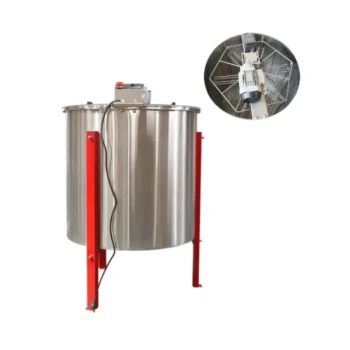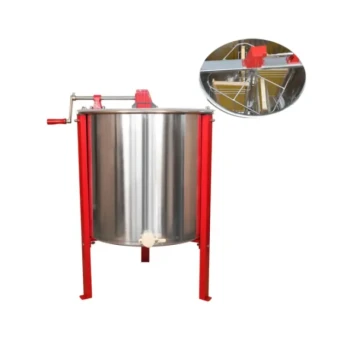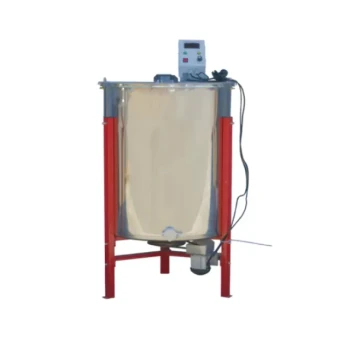In short, decanting honey is a critical clarification process. It involves letting freshly extracted and filtered honey rest in a container for an extended period, typically around two weeks. This allows gravity to naturally separate the heavier honey from lighter impurities like fine wax particles and air bubbles, which rise to the top to be skimmed off.
The fundamental purpose of decanting is to use the natural principle of density to achieve a purer, clearer, and more shelf-stable final honey product without the need for aggressive filtering or heating.

The Principle: Using Gravity for Purification
The process of decanting works because honey and its common impurities have different densities. It’s a simple, patient method that leverages physics to refine the final product.
How Separation Occurs
Honey is incredibly dense and heavy. In contrast, microscopic wax particles, pollen, and air bubbles introduced during extraction are much lighter. When left undisturbed, these lighter elements will slowly but surely float to the surface.
What Rises to the Top
The layer that forms on top is often a mix of foam, bubbles, and fine particulates. This includes tiny bits of wax that made it through the initial straining process and air that was whipped into the honey during the spinning of the extractor.
The Importance of Time
Honey's high viscosity, or thickness, is the reason this process takes time. The lighter impurities must fight their way through the thick liquid to reach the top. A resting period of one to two weeks is standard to ensure this separation is complete.
Common Steps in the Process
Decanting isn't an isolated step but part of a larger workflow. It follows initial filtering and precedes bottling.
From Extractor to Strainer
Immediately after being spun out of the comb in an extractor, honey is typically passed through a series of progressively finer strainers. This removes large debris like beeswax chunks and other hive matter.
The Decanting Vessel
The strained honey is then transferred into a decanting container, often called a "settling tank" or "honey ripener." These are typically food-grade vessels with a gate or valve at the bottom, allowing the pure honey to be drained off without disturbing the top layer.
Skimming and Bottling
After the resting period, the layer of foam and impurities is carefully skimmed off the surface. The clarified honey below is then ready to be drained from the bottom gate of the tank and bottled as the finished product.
Understanding the Trade-offs
While decanting is highly effective, it requires patience and introduces considerations for the beekeeper.
Time vs. Final Quality
The primary trade-off is time. A two-week waiting period can feel long, especially for small-scale operations. However, this patience is rewarded with exceptionally clear honey that has a longer shelf life and better appearance.
The Impact of Temperature
Gently warming the honey (never above hive temperature, around 95°F or 35°C) can lower its viscosity and speed up the decanting process. However, overheating can destroy beneficial enzymes and negatively impact the honey's flavor and quality.
Necessity for Small Batches
For a very small harvest intended for immediate personal use, some beekeepers might skip this extended step. The honey will simply have more air bubbles and a slightly cloudy appearance but is perfectly safe and delicious to eat.
Applying This to Your Harvest
Your decision to decant should be based on the intended purpose of your honey.
- If your primary focus is producing crystal-clear honey for sale, competition, or gifting: Decanting is a non-negotiable step for a professional-quality product.
- If your primary focus is a small batch for personal use to be consumed quickly: You can choose to skip it, but understand the final product will be less clear and may crystallize faster due to the excess air bubbles.
Ultimately, decanting provides you with precise control over the purity and aesthetic quality of your final honey.
Summary Table:
| Aspect | Key Detail |
|---|---|
| Primary Purpose | Gravity-based clarification to remove fine wax and air bubbles. |
| Typical Duration | 1 to 2 weeks of resting time. |
| Key Benefit | Produces clearer, more shelf-stable honey without aggressive filtering. |
| Ideal For | Beekeepers focused on professional-quality honey for sale or gifting. |
Ready to produce professional-quality honey? A smooth harvest starts with the right equipment. HONESTBEE supplies durable, food-grade settling tanks and other essential beekeeping supplies to commercial apiaries and distributors. Let us help you streamline your honey extraction and clarification process. Contact our wholesale experts today to discuss your operation's needs!
Visual Guide

Related Products
- Electric 8 Frame Honey Spinner Extractor Equipment for Beekeeping
- HONESTBEE 72 Frame Industrial Electric Honey Extractor for Beekeeping
- HONESTBEE 6 Frame Self Reversing Electric Honey Extractor for Beekeeping
- HONESTBEE 4 Frame Manual Self Reversing Honey Extractor for Beekeeping
- Professional 4 Frame Self Reversing Electric Honey Extractor for Beekeeping
People Also Ask
- What are the benefits of using a honey extractor? Maximize Harvest & Save Bee Energy
- What machines are needed in beekeeping besides basic tools? Scale Your Honey Harvest Efficiently
- What equipment is needed for extracting honey? A Complete Guide for Every Beekeeper
- How long should you spin honey for? Master the Art of Efficient, Safe Extraction
- What are the best storage conditions for a honey extractor? Protect Your Investment for Next Season



















